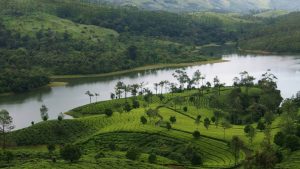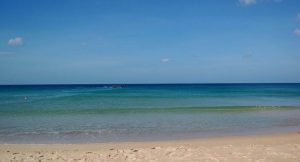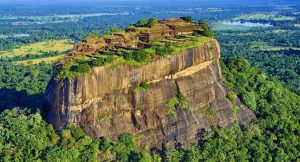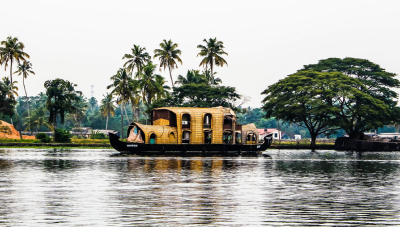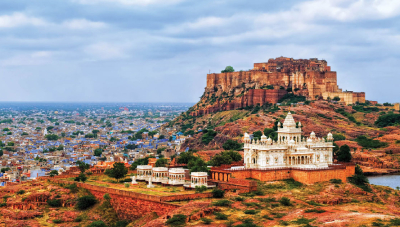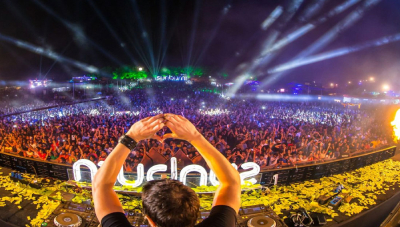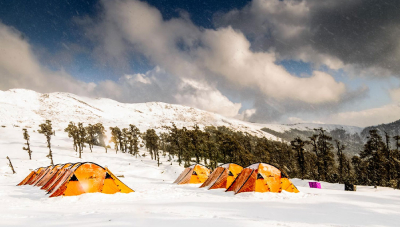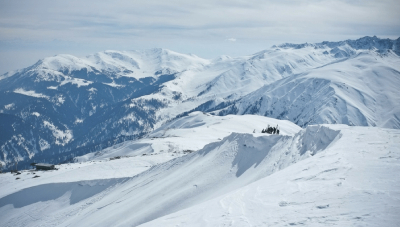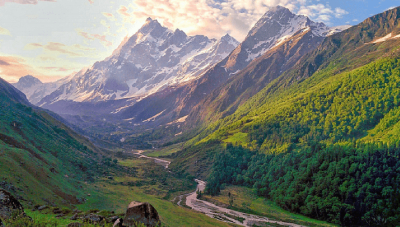Have you been looking for a blend of adventure, trekking, nature and spiritual retreat? If yes, there can be no better region than the mystical Indian Himalayas.
Well, the Himalayan ranges are an enigma in itself, enticing travellers with its breathtaking views, glaciers, river valleys and of course, the snow-laden mountains. The beauty of the Himalayas does not just compel the adventure enthusiasts to visit it, but also those seeking self-discovery or spiritual retreat amidst a serene setting.
From Hindu temples to Buddhist monasteries, from Gurudwaras to holy lakes, the long spiritual Himalayan treks in India will not only let you attain blessings but also give you an opportunity to witness a variety of cultures.
Let’s scroll down the list of 10 spiritual treks in the Himalayas that will let you get immersed in the beauty of nature while growing spiritually.
- Shrikhand Mahadev Kailash Trek, Himachal
- Ladakh Monastery Trek
- Source of Ganges Trek, Uttarakhand
- Amarnath Trek, Jammu and Kashmir
- Satopanth Lake Trek, Uttarakhand
- Hemkund Sahib Trek, Uttarakhand
- Adi Kailash Trek, Uttarakhand
- Panch Kedar Trek, Uttarakhand
- Kinner Kailash Trek, Himachal
- Phugtal Monastery Trek, Ladakh
Also Check Out
Shrikhand Mahadev Kailash Trek: A Sacred Himalayan Trekking Experience to Attain Blessings from Lord Shiva

One of the most challenging pilgrimage treks in India, Shrikhand Mahadev Kailash Trek starts from the base point Jaon or Sinhgad village in Kullu district of Himachal Pradesh to the peak of Shrikhand Mahadev, where a rock-made Shivling is around 75 feet in height. The trek is around 32 km on one side and will take you through rocky moraine path, dense forests, and rough glacier covers. The Shivling, when looked from the front, has cracks in it and for this reason, it is named as Shri ‘KHAND’ Mahadev. Being here is a magical moment, as the whole experience brings thrills along with the divine waves of emotions amidst the heart-stopping views all around.
There are many legends behind Shrikhand Mahadev. According to the Hindu mythology, Bhasmasura (a demon who was granted the power to burn up anyone by touching them with his hand) meditated for several years. Lord Shiva got pleased and gave him ‘bhasama kangan’ (the invisible power). Due to pride and ego, Bhasamasura started using the power of Lord Shiva. Because of this, Mahadev disappeared into the cave and later appeared on a hilltop, presently known as Shrikhand Mahadev Peak. Legend also reveals that the Pandavas had undertaken the pilgrimage to Shrikhand Mahadev Kailash.
Trekking Route
- Jaon Village to Singhad Village (approx 4 km)
- Singhad Village to Barhati Nala (approx 2.5 km)
- Barhati Nala to Thachru (approx 5 km)
- Thachru to Kali Ghati (approx 3 km)
- Kali Ghati to Bheem Duari (approx 8 km)
- Bheem Duari to Parvati Bagicha (approx 3 km)
- Parvati Bagicha to Nayan Sarovar (approx 3 km)
- Nayan Sarovar to Shrikhand Mahadev Peak (approx 5-6 km)
Altitude: Approx 5,715 m.
Grade: Difficult
Best Time for Shrikhand Mahadev Kailash Trek: Usually, the best time for the pilgrimage tour is between July and August. However, the rest of the planning depends on the weather forecast.
Also Read: Best Trekking Season in Himachal Pradesh
Ladakh Monastery Trek: Spiritual Trekking to Witness the Ancient Monasteries and Rich Local Culture
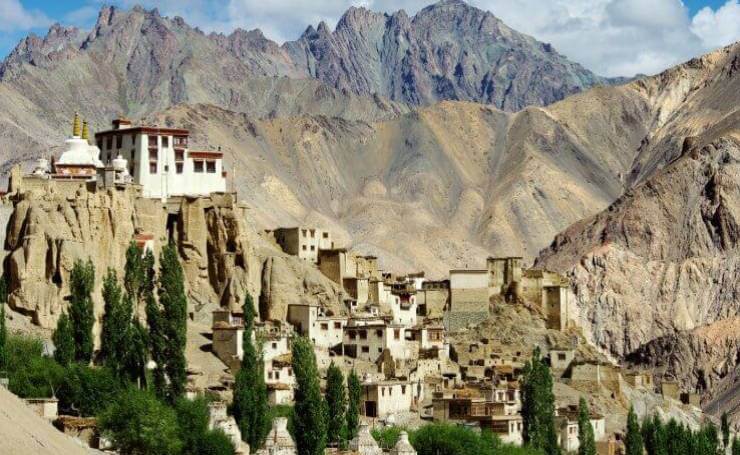
When talking about the best spiritual treks in India, we can’t miss out on the land of monasteries i.e., Ladakh. The monasteries in Ladakh are true emblem either of the Mahayana or the Hinayana sect of Buddhism. The trek will give you an opportunity to witness the rich local culture by visiting the remote village and monasteries (dating back to the 10th and 11th century) situated amidst snow-covered peaks.
The 13-day Ladakh Monastery trek begins from Leh and covers some of the most beautiful monasteries like Shey and Thiksey Monastery, Lamayuru Monastery, Prinkiti La, Hinju, Konzke La, Sumda Chenmo, Sumda Choon, Lanak and Alchi Monastery. The beauty of monasteries in Ladakh is such that most of them are built on the lone rocks or craggy mountain faces making the region stand out from any other place.
Altitude: Approx 3,600 m. – 4,950 m.
Grade: Moderate
Best Time for Ladakh Monastery Trek: The summer months between April and June are the best for a spiritual trekking experience in Ladakh.
Also Check Out: Other Popular Moderate Treks in Leh Ladakh
Source of Ganges Trek: Spiritual and Adventurous Getaway To Witness the Snout of Gangotri Glacier

One of the best destinations for a spiritual trek in the Garhwal Himalayas, Source of Ganges Trek is surely going to make your spiritual journey a sublime one. Gaumukh (Cow’s mouth) on the Gangotri Glacier is the source from where the sanctified river Ganges originates, and so the trek takes the travellers to the divine spot by covering the trekking route from Gangotri that can be reached from Uttarkashi. Upon travelling, the trek will take you to a world of holiness, wilderness and immense natural beauty.
Trekking Route
- Trek begins from Gangotri to Bhojbasa (approx 14 km)
- From Bhojbasa head to Gaumukh (approx 2-3 hours)
Altitude: Approx 4,023 m.
Grade: Easy to Moderate
Best Time for Source of Ganges Trek: The months between May and mid-October is the best time for planning a trekking vacation to Source of Ganges as it is also the season of Char Dham Yatra.
Also Read: Best Time for Trekking in Uttarakhand
Amarnath Trek: A Holy Experience of Discovering the Treasure in the Himalayas

Yet another fabled trek in the Himalayas, Amarnath Cave Trek in Kashmir gives devotees an opportunity to visit the popular cave of Lord Shiva. The trek covers the rugged and challenging mountain terrains to take the mightiest glance at the ice stalagmite formed inside the Amarnath cave.
Legends say Lord Shiva had chosen this particular cave to tell Goddess Parvati the secrets of life and death on their way to a cave. Even though it was difficult to reach, the secret was sacred, so at Pahalgam he had to leave his ride Nandi, at Chandanwari he left the the moon atop his head, at Lake Sheshnag he left the snake around his neck, and at Panchtarni he left the five basic elements of life that he carried, and he even left his son – Lord Ganesha at Mahaguna top. And since then, devotees started following the same trekking route for Amarnath Yatra.
Trekking Route
- Trek begins from Pahalgam to Chandanwari (approx 15 km)
- From Chandanwari to Lake Sheshnag (approx 7 km)
- From Sheshnag to Panchtarni to Mahagun Pass to Amarnath Cave and back to Panchtarini (approx 17 km)
Altitude: Approx 3,888 m.
Grade: Easy to Moderate
Best Time for Amarnath Trek: The only time in the year when Amarnath Cave is accessible is between Shravan months (Hindu calendar) July and August.
Satopanth Lake Trek: A Short and Spiritual Hiking Experience to Take a Dip in the Holy Water

Being one of the highest altitude lakes in the Indian Himalayan region, Satopanth Lake holds a great religious significance amidst the people. The trek to Satopanth Lake will let you enjoy the abundant natural beauty of snow-clad peaks, gushing rivulets and streams, verdant hills covered with pine and oak trees, and a lot more that cannot be explained in words, but when witnessed through naked eyes, can make you go, ‘wow’. The trek begins from Mana, a remote village that is located approx. 3 km up from Badrinath. However, the difficult part of the trek will start after reaching Laxmi Van and heading forward to Chakratirtha and finally reaching Satopanth Tal.
The spiritual history of Satopanth Lake is quite fascinating, and there are many legends behind the lake being considered pious. According to one of them, the holy trinity featuring Lord Brahma, Vishnu and Shiva took bath in the lake and meditated here on an auspicious day. It is also believed, for this reason, that Satopanth Tal Lake is a triangular crystal-clear lake. Also, according to the Mahabharata, it is through this lake, that the five Pandava brothers and their wife Draupadi, made their way to Swargarohini Peak, the way to heaven.
Trekking Route
- Trek from Badrinath to Mana Village (approx 3 km)
- From Mana to Laxmi Van (approx 9 km)
- From Laxmivan to Chakratirtha (approx 11 km)
- From Chakratirtha to Satopanth Lake (approx 5 km)
Altitude: Approx 4,600 m.
Grade: Easy to Moderate
Best Time for Satopanth Lake Trek: The summer months between mid-May and June, and post-monsoon months between September and October are the best time for a trekking expedition to Satopanth Lake.
Other Interesting Blog to Read
Hemkund Sahib Trek: Attain Blessings Along with Relishing the Colourful Hues of the Valley of Flowers

Nestled at a lofty height overlooking the pristine and clear waters of Hemkund, the trek will take you to the highest gurudwara, Hemkund Sahib, in Chamoli district of Uttarakhand. This spiritual and adventure destination in India not only attracts the Sikh pilgrims, but also draws trekking enthusiasts in impressive numbers. The reason is that with Hemkund Sahib Trek, one can even trek to the breathtaking Valley of Flowers, tucked atop Nanda Devi National Park. The Valley of Flowers will surely hypnotize you into the world of sprawling and colourful hues.
The trek to Hemkund Sahib starts from Govindghat and continues towards Ghangaria, a secluded place amidst a dense pine grove. Considered to be one of the best spiritual hikes in India, the train to Hemkund Sahib will give you an opportunity to embrace Mother Nature at its best. From Ghangaria, you can set off to enjoy the colourful hues of the Valley of Flowers, one of the incredible places to visit in India. Trekking in this picturesque valley will bring you face to face with rare species of flowers and a wide variety of butterflies, thereby making it a perfect setting for both photographers and adventure seekers.
Trekking Route
- The trek starts from Govindghat to Ghangaria (approx 14 km)
- From Ghangaria to Hemkund Sahib (approx 6 km)
Altitude: Approx 4,633 m.
Grade: Easy to Moderate
Best Time for Hemkund Sahib Trek: The months between mid-June and September is the best time for a trekking tour to both Hemkund Sahib and The Valley of Flowers.
Also Read
Adi Kailash Trek: A Challenging Expedition to Bow Down the Heads In Front of Baba Kailash

Adi Kailash is yet another place that you can choose for your trekking holidays in India. Located in the Pithoragarh district of Uttarakhand at a close proximity to Indian-Tibetan border. Adi Kailash is even known as Chota Kailash, Baba Kailash, Shiva Kailash, or Jonglingkong Peak. The trail towards Adi Kailash promises to take you into a land that is truly breathtaking and splendid, a view that will remain etched in your heart, mind and soul. The Adi Kailash Trek will offer you a panorama of the beautiful snow-clad peaks including Annapurna and will refresh your spiritual journey with thick forests, lush green meadows and cascading waterfalls.
The actual trek to Adi Kailash starts from Lakhanpur, which is reached after covering a distance of approx. 50 km from Dharchula. From there, the trek continues to Lamari, which is the next stop. After a night’s stay at Lamari, you will head towards Budi, from where the trek becomes challenging as it gets steep. From Budi, the next stop would be Nabi, and from here, you will head towards Nampa to the Kutti village. After spending time at the Kutti village, the next step would be towards Jollingkong through Sungchuma, from where you will finally get to bow your head in front of Baba Kailash.
Trekking Route
- Trek from Lakhanpur to Lamari (approx 9 km)
- From Lamari to Budi to Nabi (9 Kms Trek & 18 Kms Gypsy)
- From Nabi to Nampa to Kutti (14 Kms by Gypsy & Trek 6 Kms)
- From Kutti to Jollingkong (14 km)
Altitude: Approx 6,310 m.
Grade: Difficult
Best Time for Adi Kailash Trek: The months between June and September is the best time for an adventure and spiritually filled expedition to Adi Kailash.
Panch Kedar Trek: A Divine Trail to the Five Shrines of Lord Shiva
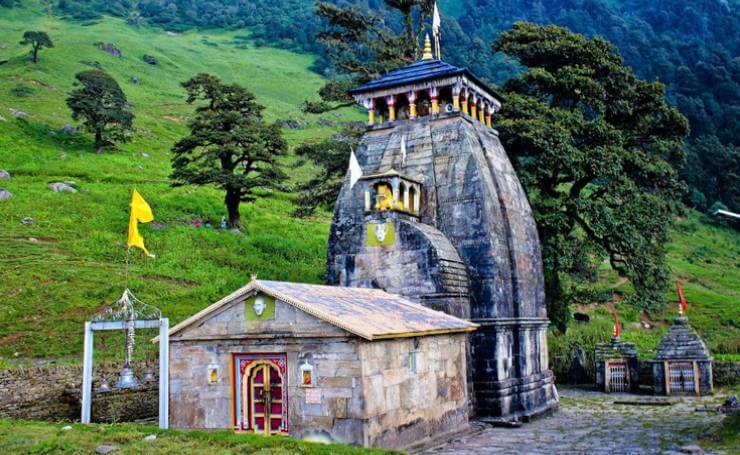
A renowned spiritual trek in the Garhwal region of Uttarakhand, Panch Kedar Trek is all about enjoying spiritual and exciting trekking holidays across the most celebrated routes of the five major shrines of Lord Shiva situated in the Kedarnath valley, comprising Kedarnath, Madhyamaheshwar, Tungnath, Rudranath, and Kalpeshwar.
The entire stretch of Panch Kedar reflects the mythical colors of the Mahabharata where the Pandavas went to meet Lord Shiva in the Himalayas. Legend says that Lord Shiva avoided meeting the Pandavas due to Fratricide (Gotra Hatya) and Brahma Hatya committed by the Pandavas. So, they had to struggle a lot to meet Lord Shiva. Bhima, the second of the five Panadavas, stood aside two mountains and started to look for Shiva. He then saw a bull grazing near Guptkashi and immediately recognized the bull to be Lord Shiva. Soon, the bull-formed Shiva disappeared into the ground, and later reappeared in parts in different places. At Pashupatinath in Nepal, the forelegs of the bull appeared, the hump at Kedarnath, the navel at Madhyamaheshwar, the arms at Tungnath, the face at Rudranath, and the matted hair at Kalpeshwar. This formed the Panch Kedar in India, excluding Pashupatinath in Nepal.
Trekking Route
- Trek from Helang to Urgam (approx 9 km)
- From Urgam to Kalpeshwar, the first of the Panch Kedar Trek (approx 2 km)
- Back to Urgam to Kalgot (approx 12 km)
- From Kalgot to Rudranath, the second of the Panch Kedar Trek (approx 12 km)
- From Rudranath to Sagar to Mandal (approx 18 km trek/8km drive)
- From Mandal to Chopta to Tungnath, the third of the Panch Kedar Trek (19 kms drive/ approx 3.5 kms trek)
- Trek back to Chopta from Tungnath (approx 3-4 km)
- A drive covering 45 km will take you to Jagasu from Chopta.
- From Jagasu trek to Gaundhar (approx 12 km)
- From Gaundhar trek to Madhyamaheshwar, the fourth of the Panch Kedar Trek (approx 18 km)
- Return back to Gaundhar from Madhyamaheshwar
- From Gaundhar trek back to Jagasu (approx 12 km) and drive to Guptkashi (approx 30 km)
- From Guptkashi drive to Gaurikund and from Gaurikund Trek to Kedarnath, the fifth of the Panch Kedar Trek (approx 14 km)
Altitude: Approx 4,090 m.
Grade: Moderate
Best Time for Panch Kedar Trek: The months between May and October is the best time to plan your Panch Kedar Trek.
Also Read
Kinner Kailash Trek: The Mythical Home of Lord Shiva
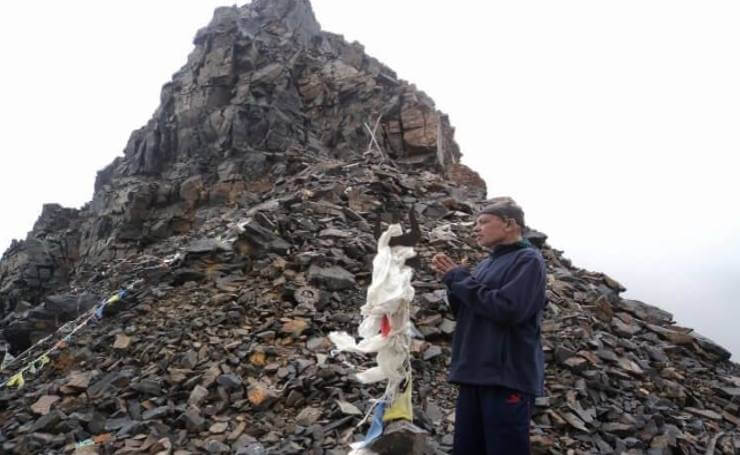
Also dubbed as the Kinner Kailash Parikrama, the dreamlike spiritual trek will take you into the wilderness of the Kinnaur region in Himachal Pradesh. Considered to be yet another of the challenging treks in the Indian Himalayas, Kinner Kailash Trek brings you close to the mythical abode of Lord Shiva. As you trek, you will get to witness the unparalleled scenic vistas of beautiful meadows, hanging glaciers and towering peaks by making your way through the treacherous trails, ascending narrow paths and crossing large water streams. Not just this, but owing to the valley’s close proximity to Tibet, you will get to see the unique blend of Hinduism and Buddhism cultures and the pagoda style monasteries.
The trek to Kinner Kailash begins from Tangling, a village situated on the left bank of the river Sutlej. From here the trek continues through a metalled pathway upto a small stream about 3 km ahead. After taking two halts, one at Bara Pathar (Big Stone or Rock) and other at Bara Ped (Big Tree), the trek proceeds further and after crossing the bugyals (meadows), the day ends at Ashiqui Park, from where Kinner Kailash is approx. 8-10 km away. From Ashiqui Park, the night view is amazing and the lights of Kalpa and Reckong Peo can be clearly seen. The next morning, trek from Ashiqui Park starts towards Bheem Dwar, which is the first halt covering a distance of approx 3-4 km. Soon the treks brings to the Parvati Kund, the second halt covering a distance of approx 3 km. From Parvati Kund take a vertical climb of around 2.5-3 km to reach Kinner Kailash, while passing through small caves, moraines, and patches of snow bedded on the slope.
Trekking Route
- Trek from Tangling to Ashique Park (approx 8-9 km)
- From Ashique Park to Bheem Dwar (3-4 km)
- From Bheem Dwar to Parvati Kund (approx 3 km)
- From Parvati Kund to Kinner Kailash (2.5-3 km)
Altitude: Approx 6,500 m.
Grade: Difficult
Best Time for Kinner Kailash Trek: The months between May and June, and post-monsoon in the month of October, is the best time to witness the beauty of Kinner Kailash.
Also Read: Popular Trekking Peaks in Himachal Pradesh
Phugtal Monastery Trek: An Isolated Site Amidst Cold Desert to Attain Peace and Solitude

When you think of a remote destination for spiritual trekking in India, Phugtal Monastery Trek can’t be missed. Nestled in the remotest corner of the of Lungnak Valley in the south-eastern Zanskar region of Ladakh, Pughtal Monastery or Phugtal Gompa is one of the most enchanting sites you will come across. What makes the monastery more fascinating is the fact that it is built around a natural cave in the cliffside, like a honeycomb. So, if peace and solitude is what you seek amidst a cold desert mountain setting, Phugtal Monastery Trek is where you will attain it.
The trek to Phugtal Monastery begins from Ichar and heads to Anmo/Anmu, covering a trek of around 4-5 hours. From Anmo, the trek continues to Cha, from where the trek to Phugtal begins. The trail from cha is a bit narrow, and it takes around 2-3 hours to reach Phugtal Monastery. Once done with exploring the monastery, trek down to Purne from the monastery, which is approx. 2 hours trek, and from Purne to Anmo and back to Ichar.
Trekking Route
- Trek begins from Ichar to Anmo (should take around 4-5 hours)
- From Anmo to Cha (around 2 hours)
- Cha to Phugtal Monastery (around 2-3 hours)
Altitude: Approx 4,000 m.
Grade: Moderate
Best Time for Phugtal Monastery Trek: The months between June and September is best to visit the awe-inspiring isolated Buddhist monastery.
Other Interesting Blogs to Read
With this I would like to wrap up the blog. I hope you are done with deciding where to go for your spiritual trekking expedition in the Himalayas. Do let us know which spiritual places in India will you be visiting and also if you have ever been to any of these Himalayan treks, do share your experience in the comment section below. We would love to read your travel stories.
Also, in case you need any assistance in planning your trip, looking for the best holiday packages or want to know any other best trekking sites in India, give us a call at +91-9212553109 or drop your queries at info@tourmyindia.com.
Like & Follow our social media accounts at Twitter, Facebook, Linkedin & Instagram for getting the latest updates & offers on holiday packages.
Disclaimer: We do not take credit for some of the licenced paid images used in our blogs, whether from Google Images, Fotolia & Shutterstock. All such images are the copyrights of their respective owners and we try to provide credit for them wherever we can. If, however, any copyright image has been used on our blog, the concerned person can either mail us directly to remove the image or provide credit to whomsoever the image may belong to.
Frequently Asked Questions
Q.What are the best spiritual treks in Himachal Pradesh?
Shrikhand Mahadev Kailash Trek and Kinner Kailash Trek are the best spiritual treks to experience in Himachal Pradesh.
Q.What are the best spiritual trekking and adventurous getaways in Uttarakhand?
The best spiritual and adventurous getaways in Uttarakhand are:
- Panch Kedar
- Hemkund Sahib
- Adi Kailash
- Source of Ganges Trek
- Satopanth Lake Trek
Q.Can I do Hemkund Sahib along with the Valley of Flowers?
Yes, you can get the best trekking experience of Hemkund Sahib along with the Valley of Flowers. The trail to both the treks divides from Ghangaria.
Q.Which are the difficult pilgrimage treks in the Himalayas?
Shrikhand Mahadev Kailash Trek, Kinner Kailash Trek and Adi Kailash Trek are some of the most difficult treks in Indian Himalayas.
Q.Which are the easy to moderate religious treks in the Garhwal Himalayas?
The easy to moderate spiritual treks in the Garhwal Himalayas are Source of Ganges Trek, Satopanth Lake Trek, and Hemkund Sahib Trek.
Q.Which are the best spiritual & adventure treks to take in the Himalayas in summer, monsoon & winter season?
- For Summer Season: Ladakh Monastery, Source of Ganges, Satopanth Lake Trek, Panch Kedar, and Kinner Kailash Trek.
- For Monsoon Season: Shrikhand Mahadev Kailash Trek, Hemkund Sahib Trek, Amarnath Trek, Source of Ganges Trek, Adi Kailash Trek, Phugtal Monastery Trek, and Panch Kedar Trek.
- For Winter Season: Sources of Ganges Trek, Satopanth Lake Trek, Panch Kedar Trek, and Kinner Kailash Trek.
Q.Where can I go for a spiritual trekking in Ladakh?
Phugtal Monastery and Ladakh Monastery treks will give you the best spiritual trekking experience in Ladakh.
Q.Which is the best sacred Himalayan trekking expedition in Kashmir?
Amarnath Cave trek is the best spiritual Himalayan trek in Kashmir.
About the author
Born and brought up in Assam- ‘The Land of Tea Gardens’, Swati is a Travel Writer who yearns to travel around the whole world someday. Coming from one of lush-green and peaceful states of India, her love for nature and rain is beyond imagination. She is an observant and is keen to explore more about the things that comes her way which could be clearly seen in her write ups. Other than this, she is a foodie and can do anything for food that is made out of cheese especially- The Alfredo Penne Pasta!

 +91-9212777225
+91-9212777225 Plan Your trip
Plan Your trip













